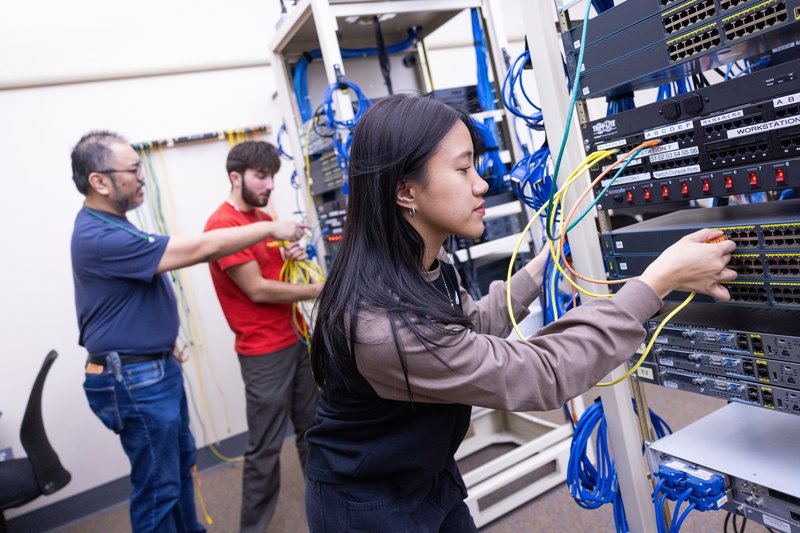Turning Students' Current Jobs into Paid Internships in New Mexico
Blog Post

Photo by Allison Shelley Complete College Photo Library
July 28, 2025
Paid work-based learning opportunities lead to higher wages for graduates. Yet, many working community college students cannot participate because they are so busy with school and their jobs. Most work-based learning opportunities don’t pay enough to replace regular employment. But what if community colleges could work with a student’s current employer to create a paid on-the-job learning opportunity? Central New Mexico Community College (CNM) is doing just that.
Turning Current Work into Work-Based Learning
Early this year, CNM started identifying employers who could create paid internships for their employees enrolled at the college, using their current positions as the site of on-the-job learning. The college finds these possible internships through word of mouth among employers, intake forms of students working with the college's work-based learning staff, and employment advisers who meet with students.
According to Brenden Kennedy, Associate Director for Internships, “The hard part is finding out where people are working, and if they're working in their field part-time, so that's an ongoing project with faculty and department chairs.” As Kennedy and his team develop this job-to-internship program, they plan to make evaluating students’ current jobs more streamlined and automatic.
So far, the college has facilitated around a dozen of these internships in accounting, auto and diesel mechanics, culinary, hospitality, and paralegal programs. One employer approached Kennedy and shared that they had an employee “who's doing regular auto mechanic stuff. But he's shown interest in diesel. So [the employer is] actually sending him to CNM and paying for his tuition, and he's shadowing their master diesel mechanic.” With their internship funds from state higher education workforce allocations, CNM subsidized this student’s wages as he learned the diesel side of the business.
These job-to-paid internship opportunities are tied to the program and sometimes course learning outcomes, granting participants credit for the experience. They also include mid-term and final check-ins with students to help them reflect on their learning.
The most significant incentive for employers to participate in the program is that they hire the intern and pay at least $15 per hour, and CNM reimburses the employer $12 per hour. Using about $1.5 million of their $11 million state workforce dollars, CNM has focused on growing paid work-based learning opportunities college-wide. Student interns must be W-2 employees, and employers must have the right liability insurance to be eligible for the wage subsidy.
How CNM Structures Work-Based Learning Collegewide
One factor that allows CNM to leverage students’ existing work into internships is the structure they use to coordinate internships and work-based learning across the college. Each department or program has its work-based learning coordinator at many colleges. For instance, health programs run their clinicals, and business programs run their internships, with little coordination and referral across the college. This decentralization makes it difficult to have the capacity to create innovative models like connecting students’ existing work to an internship.
A few years ago, CNM heard that employers wanted one point of contact at the college for program development and internships. At the time, there was no centralized reporting or support for work-based learning across the institution; it sat squarely with each program. But that was about to change. The college implemented a more federated model that preserves the faculty's role in program learning outcomes but lifts some of the administrative burden.
As part of CNM’s Workforce and Community Success division—which oversees career services and employer and community engagement—the team surveyed all 200 academic programs to map out existing work-based learning activities. The team also reviewed the collection of employer agreements and offered additional support to the programs. For example, while health programs continue to manage their clinical placements, the Workforce and Community Success team assists them in expanding their employer network when needed. Since implementing this coordinated approach, CNM has placed 600 interns, and now, 95 percent of all internships at the college are paid.
Because this is a federated model, the programs need incentives to cooperate with the Workforce and Community Success division. One incentive is the team's control of state workforce funds to support intern wages. The team also collects data on the WBL opportunities and communicates wins to the executive team, the legislature, and other college stakeholders. The programs are motivated to work with the Workforce and Community Success team because they want to document their contribution to CNM’s Strategic Plan goal of every student participating in a WBL opportunity.
Conclusion
CNM’s model strengthens connections between students’ work and education, making these work-based learning opportunities accessible and helping students progress in their careers. It strengthens relationships with employers by supporting incumbent workers while giving students credit and structured learning in their current roles. The college can support this work because of the state funding stream to which they have access.
States should consider establishing a dedicated funding stream for colleges to administer that helps supplement student intern wages. This funding can also be structured to incentivize colleges to adopt a centralized work-based learning model that preserves faculty’s role in overseeing academic outcomes while fostering innovation, such as turning students’ current jobs into meaningful internship experiences.